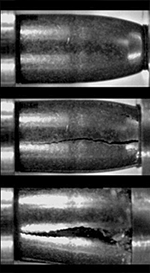Frangible
Frangible , engl. for "fragile" (from Latin. frangere , break) refers to the property of a material where deformation to fragment into a plurality of parts instead of as a whole to be deformed plastically . The effect in the target is slightly different from fragmentation grenades with delay fuses.
In weapons technology in particular, the term “frangible” stands for the property of special projectiles that fragment into very small parts when they hit hard targets .
These projectiles are formed from metal particles or fine metal powder. The starting material is either hot or cold sintered or the metallic base material is pressed into molds with a plastic as a binding agent.
As early as the Second World War, attempts were made to make projectiles from powder materials. The main aim was to reduce the use of economical materials in production. Bullets have been made of powdery material again since 1992 at the latest. The impetus for the development came primarily from the Delta Frangible Ammunition company . One of the main reasons was the search for environmentally friendly bullet materials in order to reduce or completely avoid the exposure of shooting ranges and shooters with lead and other harmful substances by combining them with low-pollutant primers . Additional advantages are the inexpensive production and the reduction in the risk of ricochets or bullets.
The strength of modern frangible projectiles is adjusted so that when they hit a target made of harder material they burst into very small pieces from an impact angle of 20 °. Even when hitting soft targets such as ballistic soap, the projectiles disintegrate very quickly, so that the probability of a penetration is significantly lower compared to a partial or full jacket projectile.
Some types of bullets have metal particles embedded in nylon , others use polyester . Tungsten-copper powder mixtures, tungsten-zinc mixtures, iron-zinc mixtures and other combinations are used as bullet materials. Conductive projectiles can be galvanically copper-plated, non-conductive metal-plastic compound materials can be provided with a tombac jacket .
Frangible bullets are offered by numerous manufacturers in both factory cartridges and for reloaders .
See also
Individual evidence
- ↑ a b Jens Tigges: Projectiles of the future. in: caliber. Edition 03/2004, Vogt-Schild Deutschland GmbH Cologne, p. 6 ff.
Web links
- Frangible Ammunition (accessed October 14, 2019)
- Evaluation Method of Frangible Bullets Frangibility (accessed October 14, 2019)
- Theoretical Criterion for Evaluation of the Frangibility Factor (accessed October 14, 2019)
- LEAD FREE FRANGIBLE AMMUNITION EXPOSURE AT UNITED STATES AIR FORCE SMALL ARMS FIRING RANGES, 2005-2007 (accessed October 14, 2019)
- The Benefits of Frangible Bullets (accessed October 14, 2019)
